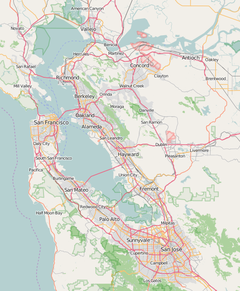Antioch Bridge
| Antioch Bridge | |
|---|---|

Antioch Bridge (2014)
|
|
| Coordinates | 38°01′28″N 121°45′02″W / 38.0244°N 121.7506°WCoordinates: 38°01′28″N 121°45′02″W / 38.0244°N 121.7506°W |
| Carries | 2 lanes of |
| Crosses | San Joaquin River |
| Locale | Antioch, California and Sacramento County, California, U.S. |
| Official name | Senator John A. Nejedly Bridge |
| Owner | Caltrans |
| Maintained by | Caltrans and the Bay Area Toll Authority |
| ID number | NBI 28 0009 |
| Characteristics | |
| Design | steel plate girder |
| Total length | 9,504 feet (2,897 m) |
| Width | 38.1 feet (11.6 m) |
| Longest span | 460 feet (140 m) |
| Clearance below | 135 feet (41 m) |
| History | |
| Opened | December 1978 |
| Replaces | 1926 lift bridge |
| Statistics | |
| Daily traffic | 13,600 (2009) |
| Toll | Cars (northbound only) $5.00 (cash or FasTrak), $2.50 (carpools during peak hours, FasTrak only) |
|
|
The Antioch Bridge (officially the Senator John A. Nejedly Bridge) is an automobile, bicycle, and pedestrian bridge that crosses the San Joaquin River linking Antioch, California with Sherman Island in southern Sacramento County, California, near the city of Isleton, California in the United States. Named after California State Senator John A. Nejedly, the bridge is signed as part of State Route 160. Unlike other toll bridges in California, the Antioch bridge has only a single lane of traffic for each direction.
The current bridge was completed and opened to traffic in December 1978. It is 1.8 miles (2.9 km) long.
The original structure was completed in 1926 by the American Toll Bridge Company (Aven Hanford and Oscar Klatt), who went on to build the original span of the Carquinez Bridge. The bridge was opened on 1 January 1926 as a connecting link on the coast-to-coast Victory Highway. Hanford and Klatt, officials with the Rodeo-Vallejo Ferry Company, had organized the American Toll Bridge Company in 1923, which built the bridge at a cost of greater than US$2,000,000 (equivalent to $28,110,000 in 2016).
The Delta Bridge corporation had formed in December 1922, but did not complete a bridge at Antioch. Delta Bridge had received a franchise to build in June 1923.
The 1926 bridge featured two spans each 270 feet (82 m) long which provided a clearance of 70 feet (21 m) below when opened. The original lift span bridge was plagued with problems throughout its lifetime. Heavy traffic could cross it at no more than 15 miles per hour (24 km/h), and its narrow shipping channel led to collisions with freighters in 1958, 1963 and 1970.
In 1937, Assemblyman Earl D. Desmond urged the California Toll Bridge Authority to acquire the Antioch Bridge. Desmond believed that by purchasing the bridge, tolls could be eliminated, which would spur economic growth. Director Frank W. Clark negotiated with the American Toll Bridge Company, and the state of California acquired ownership of both the Antioch and Carquinez Bridges at a cost of US$5,943,000 (equivalent to $101,600,000 in 2016) on September 16, 1940. Tolls were reduced immediately and further reduced in 1942.
...
Wikipedia

